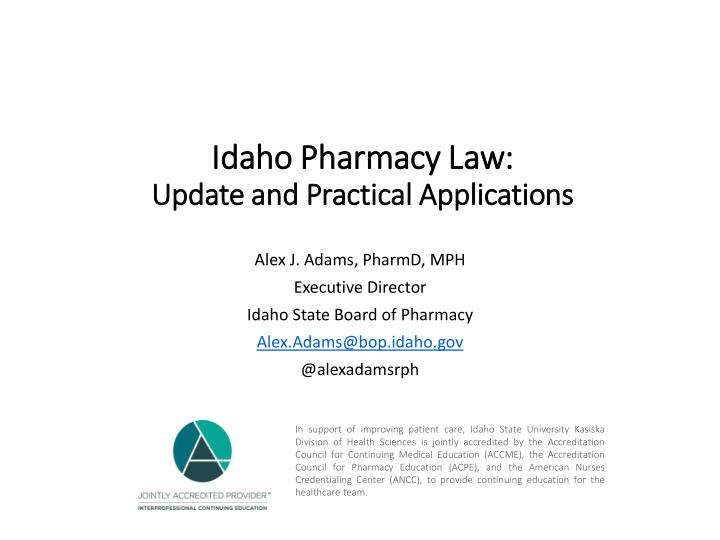



Id Idaho Pharmacy La Law: Update and Practic ical Applic lications Alex J. Adams, PharmD, MPH Executive Director Idaho State Board of Pharmacy Alex.Adams@bop.idaho.gov @alexadamsrph In support of improving patient care, Idaho State University Kasiska Division of Health Sciences is jointly accredited by the Accreditation Council for Continuing Medical Education (ACCME), the Accreditation Council for Pharmacy Education (ACPE), and the American Nurses Credentialing Center (ANCC), to provide continuing education for the healthcare team.
Disclosure • The planners and presenter of this presentation have disclosed no conflict of interest, including no relevant financial relationships with any commercial interests
Idaho Board of Id f Pharmacy Richard de Blaquiere Kristina Jonas Nicole Chopski Holly Henggeler Ed Sperry
Learnin ing Obje jectiv ives • Discuss the 2018 statutory changes impacting the profession of pharmacy in Idaho • Discuss the 2018 rule changes impacting pharmacy practice in Idaho • Describe potential law changes for 2019 and beyond
Re-organization of Rule Book 1. General Provisions 2. Rules Governing Licensing and Registration 3. Rules Governing Pharmacy Practice 4. Rules Governing Pharmacist Prescriptive Authority 5. Rules Governing Compounding 6. Rules Governing DME, Manufacturing, and Distribution
Chapter 1 – General Provisions Practice of Pharmacy: General Approach • Express Prohibition . • Education and Training . The act is consistent with licensee’s education, training or practice experience. • Standard of Care . Performance of the act is within the accepted standard of care that would be provided in a similar setting by a reasonable and prudent licensee or registration with similar education, training and experience.
Chapter 1 – General Provisions Unprofessional Conduct: • Standard of Care. Providing healthcare services which fail to meet the standard provided by other qualified licensees or registrants in the same or similar setting. • Unnecessary Services or Products. Directly promoting or inducing for the provisions of health care services or products that are unnecessary or not medically indicated.
Chapter 2 - Li Licensing • Remove need for separate Controlled Substances registration for pharmacists • Establish pharmacist renewal fee at $130 and set renewal deadline as last day of birth month • Streamline pharmacist CPE requirements: 15 hours period (max of 3 from CME) • Standardize technician-in-training at two years and remove practice site requirement; set at $35 • Create a student technician category of registration • Facilities: allow temporary license number, remove need for remodel paperwork, streamline closing, set renewal deadline as December 31
Chapter 3 - Pharmacy Practice • Defer more to pharmacist professional judgment vs. micromanaged rules • Create breathing room for new practice models and technology to emerge • Focus on “practice of pharmacy” not “business of pharmacy” • Focus on “what” must occur not “how” it occurs • Remove PIC employment reporting requirement
Chapter 3 - Pharmacy Practice • Expanded emergency refills • A pharmacist may refill a prescription for a non-controlled drug 1 time in a 6 month period – up to the quantity on the most recent fill or a 30-day supply, whichever is less. • Adapting a prescription (excluding controlleds, biologics, compounds) • A pharmacist may change the quantity of a medication if the prescribed quantity or package size is not commercially available • A pharmacist may change the dosage form if it is in the best interest of patient care
Chapter 4 - Prescribing Establish general requirements: • Education • Patient-Prescriber Relationship • Use of evidence-based protocol • Specify inclusion, exclusion, medical referral criteria • Follow-up care plan • Notification to primary care provider within 5 business days • Documentation
Chapter 4 - Prescribing • Minor ailments: lice, cold sores, uncomplicated UTIs, motion sickness prevention • CLIA-waived tests: influenza, strep throat • Devices: spacers, nebulizers, diabetes testing supplies, pen needles, syringes. • Gaps in care: SABA for patient with long-term controller, statins for patients with a diabetes diagnosis • Supplement to infusion order: flush, devices, supplies, local anesthetics for port access • Misc: international travel prophylaxis, lyme disease prophylaxis • Emergency use: epi, diphenhydramine, SABA
Re-organization of Rule Book 1. General Provisions 2. Rules Governing Licensing and Registration 3. Rules Governing Pharmacy Practice 4. Rules Governing Pharmacist Prescriptive Authority 5. Rules Governing Compounding 6. Rules Governing DME, Manufacturing, and Distribution
H339 – Th Therapeutic Substitution • Allows substitution within the same therapeutic class if three things happen: • Prescriber opt-in by making a designation on the Rx • The substitution ensures formulary compliance • The patient opts-in • Bill carves out biological products and narrow therapeutic index drugs
Learnin ing Obje jectiv ives • Discuss the 2018 statutory changes impacting the profession of pharmacy in Idaho • Discuss the 2018 rule changes impacting pharmacy practice in Idaho • Describe potential law changes for 2019 and beyond
Id Idaho Pharmacy La Law: Update and Practic ical Applic lications Alex J. Adams, PharmD, MPH Executive Director Idaho State Board of Pharmacy Alex.Adams@bop.idaho.gov @alexadamsrph
Recommend
More recommend